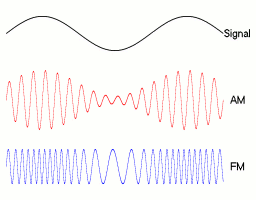Frequently used and often overlooked, the radio has played an important role in our lives and the lives of those before us. The mysteries of radio are abandoned because we simply expect wonderful sound to emanate from the speakers when the power is switched on. Seldom do we ponder the physics behind how the radio is able to deliver broadcast sound. Even more infrequently do we wonder what engineers have done to help us use and harness the power of radio waves. Exploring the phenomenon of radio waves will make you more aware of what occurs behind the scenes every time you tune that dial.
Introduction
You are driving down the open road, not a care in the world. It’s a sunny summer day and you have the car windows down. Everything seems almost perfect, yet something is missing. You turn on the radio, tune it to your favorite station (see Fig. 1), and instantly the car fills with sound. Suddenly, everything feels right. Radio is something most of us take for granted. Have you ever stopped to consider how a radio works? How does a radio know which station to play? What is AM, what is FM, and how are the two different? Why does FM sound better, but AM can be heard farther away? You have probably experienced a time when finding a particular radio station has been difficult. There are many factors involved in finding and receiving stations, factors such as modulation, broadcasting power, time of day, and geographical location. The key to getting the most out of your radio is to understand how radio works and how engineering has played a part in the development of a device which most of us use everyday.
Radio Basics
In order for you to hear your radio, a few things must happen. First, the radio station encodes some information on a radio wave. This is known as modulation. They then broadcast the radio wave with the encoded information onto a certain frequency. Your radio antenna picks up the broadcast based on the frequency to which your radio dial is tuned. Your radio then decodes the information from the radio wave and plays that information through the speakers as sound. So where does this information come from?
AM and FM Differences
Two characteristics, amplitude and frequency (see Fig. 2), mark the difference between AM and FM radio. AM stands for amplitude modulation, which means the amplitude of the radio signal is used to encode information. FM denotes frequency modulation, which uses a change in frequency to encode information. From this you can see that both AM and FM radio use modulation to encode information. “Modulation is the variation of some property of the radio carrier in a manner that conveys information” [1].
Modulation Explained
In order to understand why modulation is necessary, imagine a situation where you are sending a message with semaphore flags. (Semaphore is a way of representing letters and numbers by holding two flags, one in each hand, and varying the positions of the flags based on the letters or numbers you want to communicate.) First imagine that instead of varying the positions of the flags, you always hold your arms outstretched to the sides regardless of what letter you are trying to send.
In this case, every message you send will look the same. The person receiving your message will not know how to decode it, since you never did anything to differentiate one letter from another. Now imagine that a unique positioning of the flags represents each letter you wish to send (this is how semaphore actually works). For instance, arms outstretched would represent only the letter ‘R’, and your right arm outstretched with your left arm raised above your head would represent only the letter ‘P.’ Now your receiver can decode your message as long as he or she knows what letter each flag position represents.
Now that you’ve read the semaphore analogy, the idea of radio modulation should be easy to understand. If a radio station were to transmit a simple sine wave, there would be no way to encode information because the radio wave would always look the same. In order to send any useful information, the radio station would have to somehow change the shape of the radio wave. How do they change the shape? By using one of the two forms of modulation. Let’s first look at amplitude modulation.
Amplitude Modulation (AM)
How then is information actually encoded for AM radio? To begin with, you need a carrier signal. This is just a simple unmodulated sine wave, meaning a constant sine wave with no changes in amplitude or frequency. Then you need a wave that represents the message you wish to send. The amplitude of this wave will change based on the information sent. For sake of simplicity, assume you are sending letters instead of sounds. Then the letter ‘A’ might be represented by a very small amplitude and the letter ‘Z’ with a very large amplitude, with the rest of the alphabet falling respectively in between.
Once you have both the carrier and message signals, you multiply the two together. By multiplying the two, the amplitude of the carrier signal is changed according to the amplitude of the message signal.This combined wave is the actual broadcast signal. When a radio picks up this signal, all it has to do is determine the different amplitudes of the signal and convert these amplitudes back to letters.
Frequency Modulation (FM)
Now let’s look at frequency modulation. FM radio works in a similar fashion to AM radio. Again, you must first begin with a simple sine wave (see Fig. 3) as a carrier signal. The message signal is formed the same way as it is with AM radio. This time, however, instead of using the message signal to vary the amplitude of the carrier signal, the message signal is used to vary the frequency of the carrier signal. Thus, in the final broadcast signal, a low frequency will represent the letter ‘A’ and a high frequency will represent the letter ‘Z.’ When a radio receives a signal that has been frequency modulated, it decodes the changes in frequency into whatever message was sent.
Sound Quality and Performance
The choice between FM radio and AM radio does have an impact on sound quality, due to both physical and regulatory differences between the two. The next section will investigate these differences, as well as the resulting benefits and drawbacks. In addition to differences in how information is encoded, AM and FM radio differ in performance, specifically with regard to sound quality and the broadcast range. You have probably noticed while listening to the radio that FM stations tend to sound better than AM stations, but AM stations can usually be heard farther away.
Signal Strength
There are three reasons why FM sounds better that AM. The first reason is that AM radio tends to have a weaker signal strength than FM. Due to Federal Communications Commission (FCC) regulations, AM stations can not broadcast with more than 50 kilowatts of power [2].
FM stations on the other hand can broadcast at up to 100 kilowatts of power. These are only maximum values; many stations broadcast at far lower power levels. In addition, by varying the amplitude of the broadcast signal for AM radio, the power at which that signal is broadcast is also changed, since amplitude represents the strength of the signal. Thus, instead of picking up low amplitude signals, some radios may pick up no signal at all. FM radio, on the other hand, always remains at a constant amplitude, so the strength of the signal does not change.
Frequency Range
The second advantage that FM radio has is its use of a higher frequency range. AM radio operates from 535 kHz to 1605 kHz. When you tune the dial on your radio, the number changes by 10 kHz each time. This means that each station has 10 kHz of bandwidth on which to broadcast. FM radio on the other hand operates between 88 MHz and 108 MHz, and your radio increments every 200 kHz. Due to FCC regulations, an FM station may only use 150 kHz of bandwidth, but this is still 15 times that of an AM station. This means that an FM station can transmit 15 times as much information as an AM station.
Interference
The third reason AM radio does not sound as good is that AM radio tends to have a lot of interference. There are many natural sources of radio waves, most of which are AM waves, and your radio is unable to differentiate between natural AM waves and those being broadcast by radio stations. Perhaps you have noticed that AM radio tends to sound better at night than during the day. The reason for this is that the sun is a big source of natural AM radio waves.
Broadcast Range
You may be wondering now why anyone uses AM radio at all. As mentioned before, AM has one important advantage over FM, and that is its broadcast range. Imagine you are taking a cross-country road trip from Los Angeles to New York. Suppose you would like to go through Colorado, but you heard there has been a big snowstorm there and your are not sure whether the freeway you want to take will be open. It would be convenient to know ahead of time so that you could plan your route accordingly. Wouldn’t it be handy if you could find a station broadcasting Colorado traffic reports while still in California? Surprisingly, this is sometimes possible; occasionally signals originating in Denver can received here in Los Angeles. How is this possible? Since AM radio operates at a lower frequency, it has much larger wavelengths. Larger wavelength waves can travel farther because they can travel well through solid objects. FM radio waves on the other hand do not travel well through solid objects. This is the reason FM stations sometimes fade in and out when driving in mountainous areas. Another reason why AM radio waves can be heard far away is that they can be reflected off the ionosphere surrounding the earth. Lower frequency waves tend to be reflected better than high frequency waves [3]. Due to this upper atmosphere reflection, under the right conditions, it is possible for an AM station to be broadcast around the world.
Conclusion
The next time you are driving the open road with the radio playing, keep these radio principles in mind. Radio reception is dependent on many factors, including type of modulation, broadcasting power, time of day, and geographical location. Knowing the thinking of the engineers who developed radio transmission may help you find that one elusive station you are looking for. Or, perhaps, it may explain why you are unable to find it. If that happens to be the case and you have a passenger with you, turn off the radio and start a conversation. And then you can impress them with your radio knowledge.






